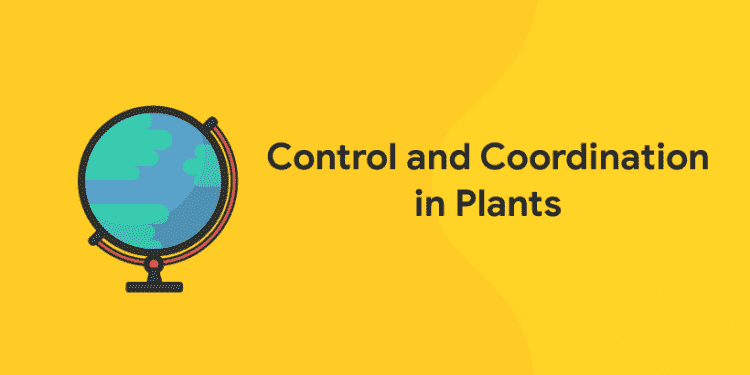Table of Contents
The nervous system controls and coordinates all the activities in an animal body. It is, in fact, a complex set of nerves and devoted cells known as the neurons which transmits signals throughout the body. However, the plants do not have a nervous system. Have you ever pondered on how does control and coordination takes place in plants?
To begin with, control is the ability to start, slow down or stop anything whereas coordination is simply the working together of various parts/organs in an organism. If a plant body lacks the control and coordinating capability, then it will not be capable to respond to any stimuli. In short, control and coordination is essential for the proper growth and development of the plant. This article will help you to appreciate the interesting facts on control and coordination in plants.
Attempt Free Online GK Quiz! Download App!
Plant Hormones
Even though plants lack a nervous system and sensory organs, they recognize and respond to things like gravity, touch, water, sunlight, etc. Plants respond to these environment stimuli by coordinating their hormones which acts as chemical messengers. The vital plant hormones responsible for the control and coordination system are:
- Auxin
- Gibberellins
- Cytokinins
- Abscisic Acid
- Ethylene
Auxin
The stem tip produces this plant hormone. It acts on the darker side of the plant by promotes stem growth / stem elongation as a result of continuous division of the meristematic tissue. It creates apical dominance in plants and elevates cell differentiation and fruit growth.
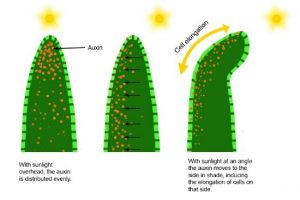
Gibberellins
This plant hormone is involved in stem elongation, flowering, breaking of seed dormancy and seed germination. It often stimulates the main stem growth when applied to a whole plant,. Thus, it is used by farmers in crop production on a large scale. However, Gibberellins do not play any role in apical dominance of the plant.
Cytokinins
This hormone accelerates plant growth by promoting cell division (cytokinesis)in plant roots and shoots. It is synthesized in the plant root and move upward through xylem. Upon reaching the leaves and fruits, it is used for plant growth and cell differentiation. Furthermore, it retards leaf senescence.
Abscisic acid (ABA)
It is a growth inhibitory hormone involved in the stomatal closure and seed and bud dormancy. As it increases the tolerance of plants to various kinds of stresses it is also called the stress hormone. Being a growth inhibitor, it definitely inhibits the shoot growth while not affecting the root growth adversely.
Ethylene
This is a versatile plant hormone capable of regulating and stimulating fruit ripening, blooming of flowers and leaf senescence. It is produced in the leaves, stem, roots, flowers, seeds and fruits. Now you know why are ethylene lamps used for ripening and color development of certain fruits!!?
All the above mentioned plant hormones can be categorized as Growth Promoters and Growth Inhibitors.
| Growth Promoter | Growth Inhibitor |
| Auxin, Gibberellin, Cytokinin | Abscisic acid (ABA), Ethylene |
Plant Movement
1: Who was the first woman President of India?
Movement in plants is different from that occurring in animals. Plants show very slow movement. It is most of the time, recognized by growth. They mostly show two types of movements namely, Tropic movement and Nastic movement.
Tropic movement/Tropism
It is the movement of a plant in response to a stimulus. It can be either be positive tropism or negative tropism. When the plant movement is in the direction of the stimuli, it is positive tropism. However, when the plant moves away from the stimuli, it is termed as negative tropism.
Based on the type of stimuli, tropisms are famously classified into five types.
- Phototropism
- Geotropism
- Chemotropism
- Hydrotropism
- Thigmotropism
Phototropism
It is the response of the plants to light. Plants have special photoreceptors called phototropins to detect light during phototropism. Most of the time, the shoot exhibits positive phototropism while the root exhibits negative phototropism.
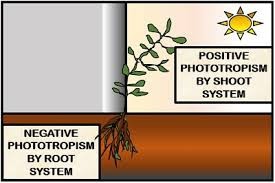
As is seen the figure above, the stem and leaves of a plant will respond to sunlight by moving towards it. But the root system tends to move away from the sunlight. In other words, the auxin hormone in plants accelerates phototropism by allowing the curvature of stems.
Geotropism
It is the response of plants to gravity. While a plant root shows positive geotropism, a plant shoot shows negative geotropism. Let us understand it better with an illustration.

Keep a potted plant in a tilted position on the ground for a few days. Then, let us observe the root and shoot growth after a few days. It will be seen that the root of the plant grows towards the earth (towards the gravitational pull) . Furthermore, the stem of the plant bends and grows upwards. So, plants respond to gravity regardless of the position of the pot . Therefore we shall conclude that the root is positively geotropic and the shoot is negatively geotropic.
Click here to Download Entri! Ace your Competitive Exam Preparation!
Chemotropism
It is the response of plants to chemicals. The growth of pollen tube towards the ovule during fertilization in a flower is positive chemotropism.

The stigma (located in the carpel) of a flower secretes a sugary chemical substance. This acts as a stimulus for the pollen grains. As a result, the pollen grains respond by growing a pollen tube into the style towards the downward direction. Eventually the pollen tube reaches the ovule for fertilization.
In this case, the growth of pollen tube is due to the chemical secretion by stigma. Therefore ,chemotropism plays an important role in fertilization.
Hydrotropism
It is the response of plants to water. The roots of a plant certainly grow towards water no matter what the circumstance .
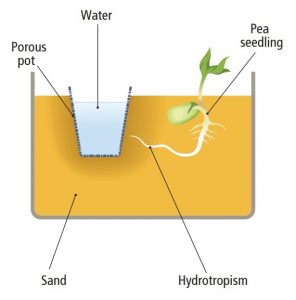
Let us learn hydrotropism with an example. First, take a glass trough filled with soil. Then, plant a seedling in one end of the trough. Further, insert a porous pot in the other end. Moreover, keep watering the porous pot for days continuously. Meanwhile, it will be observed that root has bent once we dig up the seedling . The growth of the root is towards the porous pot (towards water). Thus showing positive hydrotropism.
Thigmotropism
It is the directional response of a plant part to the touch of an object. Often called as Haptotropism, it is prominently found in the tendrils of the climbers. Moreover, it is found in clinging roots of certain plant species.

In climbers, tendrils usually look for a surface to grow. When an external climber support is given to the plants, the Auxin hormone is produced. This is as a result of the tendrils touching the support. This in turn, stimulates the other regions of the tendrils to grow.
Nastic movement
It is the non-directional response to a stimulus by plants. The stimuli may be temperature, humidity and light irradiance. Direction of the nastic movement is independent of stimulus’s position, unlike tropic movement which is stimulus dependent. It need not necessarily be a growth movement. The leaves and flower petals mostly exhibit this type of movement.
The five types of nastic movements frequently seen in plants are as follows:
- Photonastic movement
- Thermonastic movement
- Nyctinastic movement
- Thigmonastic movement
- Seismonastic movement
Photonastic movement
It is the non-directional movement of a plant part(leaf/flower) in response to light. Many flowers undergo photonastic movement as a growth movement, for instance..

The petals of flowers like Moonflower, dandelion, etc open during the day and closes in the evening based on the light intensity.
Thermonastic movement
It is the non-directional movement of a plant in response to change in temperature. Moreover, it is closely associated with photonastic movement. Likewise, it can be widely seen in flowers whose petals open with the rise in temperature and petals closes with a drop in temperature.
Nyctinastic movement
It is the movement of a plant in response to variations in light and temperature. The higher plants mostly exhibit this movement, for instance. Additionally, it is often called as the ‘Sleeping movement’. It can be calculated under photonastic and thermonastic movements. The leaflets of leguminous plants commonly exhibit this type of movement.
Thigmonastic movement
It is the non-directional movement of a plant in response to the contact of an object.
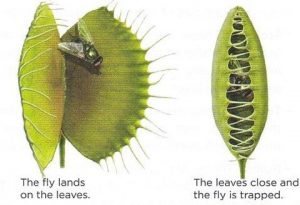
In insectivorous plants like Venus fly trap, the touch of the insect on the leaf serves as the stimuli. The leaf transmits the signal throughout. Subsequently, the tentacles bend leading to the leaf closure.
Siesmonastic movement
It is the movement of a plant in response to electrical, chemical, pressure, touch or heat stimuli. Subsequently, the plant shows a change in its structure in response to the stimuli.

The quick reaction of Mimosa pudica to mechanical stimuli is an example.
Get Higher Rank in Competitive Exams! Download Entri App!
In conclusion, control and coordination in plants is equally important as in case of animals. The basic growth and development of a plant requires the vital plant hormones. Moreover, control and coordination is essential for the systematic working of various parts of the plant. Nevertheless, it is necessary for the survival of plants itself.


